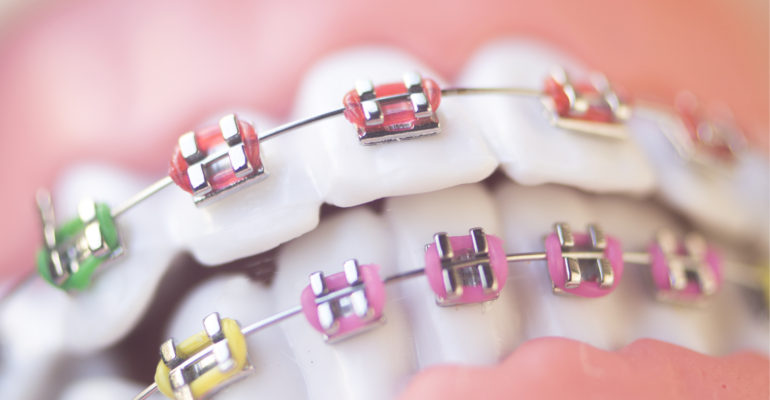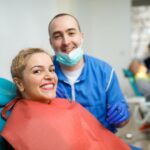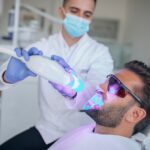Orthodontists want you to know that straightening your teeth is easier than ever before. In decades past, many patients feared having braces, both for their looks and their feel. Fortunately, new technology and better treatment methods have taken much of the stress out of getting your teeth straightened. People no longer fear the orthodontist.
October is the month to honor orthodontic health. While you don’t need to deck out your braces with festive rubber bands or fly a retainer banner, you should take a little time to consider the importance of proper orthodontic diagnosis and treatment for you and your family.
Having straight, well-aligned teeth is more than a cosmetic desire: it’s a health requirement. When your teeth do not align properly, you can suffer from a number of physical ailments.
When to See an Orthodontist
The American Association of Orthodontists recommends that children see an orthodontist no later than age 7, even if they don’t appear to have any tooth alignment problems. At that age, their jaws are still growing, and early diagnosis of an issue can lead to important early intervention. Treatment, when you are young, can mean less intensive treatments later.
Children aren’t the only ones who can benefit from orthodontics. Anyone who is unhappy with their crooked or otherwise misaligned teeth can seek treatment, which is why 20% of orthodontic patients are adults. In recent years, the stigma of adult braces has virtually disappeared.
People fifty, sixty and older have worn these appliances and finally achieved the smile they’ve always wanted. Anyone who feels uncomfortable about their smile should seek the help of a skilled orthodontist. Age should not be a determining factor in your decision to seek treatment.
Health Problems from Crooked Teeth
Misaligned teeth are not just a cosmetic problem. They can cause a number of health issues. Since they often make brushing and flossing hard to do correctly, you can end up with serious gum disease and tooth decay. The malocclusion can cause areas on your teeth to wear down, requiring extensive dental repairs such as crowns and other dental procedures. Sometimes people with misaligned teeth end up grinding them at night.
This practice can cause your teeth to crack and wear down. You may end up with headaches and poor sleep patterns. In addition, some patients can end up with TMJ, a jaw condition that can cause severe pain and other difficulties, including headaches and a “locked” jaw. Treating these problems is essential to your good health.
Treatments for Orthodontic Issues
Orthodontists offer a number of treatment options for misaligned teeth, including retainers, metal braces, ceramic braces, and removable plastic aligners. Most orthodontic patients are in treatment for one to three years. Depending on your diagnosis, you may wear a retainer part time after your braces are removed.
Many modern dental appliances are hard to detect. Some are made of clear plastic and others are placed on the back of your teeth. Modern braces are minimally intrusive. Your orthodontist will recommend the best treatment for your particular condition.
Care Routine for Orthodontic Patients
Proper oral hygiene is essential when you wear orthodontic appliances. The American Dental Hygienists’ Association recommends patients practice the Daily Four:
- Brushing -You need to brush with a soft-bristled toothbrush with rounded bristles. You should make certain to gently brush at a 45-degree angle so that you clean both the teeth and the gum line.
- Flossing – Flossing is important for everyone but particularly for those who wear braces. Food can easily become trapped due to the dental appliance, which can lead to gum and decay issues if not removed. You should gently place the dental floss next to the tooth and then pull upward in a C shape to get beneath the gum line.
- Rinsing – You should rinse your mouth with an anti-microbial mouthwash twice a day to lessen the number of bacteria in your mouth. Brushing alone only reaches about 50% of this bacteria, which can cause cavity-causing plaque to form on your teeth.
- Chewing – You may be surprised to learn your orthodontist wants you to chew gum as long as it’s the sugar-free kind. Doing so helps remove food particles, especially when you are unable to brush your teeth. It also helps reduce the effects of plaque acid and keeps your mouth moist and PH balanced, factors in preventing gum disease and tooth decay.
Orthodontic Health Month celebrates the benefits of a properly aligned bite. During October, you should also remember to practice the Daily Four whether you have braces or not. Brushing, flossing, rinsing, and sugarless gum chewing can be effective oral health tools for everyone.
If you have been thinking about visiting an orthodontist, make an appointment now. In Massachusetts, the friendly and expert staff at Your Dental Health Partners will be happy to consult with you about your family’s orthodontic needs. If you’ve ever worried about your smile, now is the time to do something about it.
For more information, visit Your Dental Health Partners website or call your closest clinic location. Remember, it’s never too late to seek treatment for your misaligned teeth.









